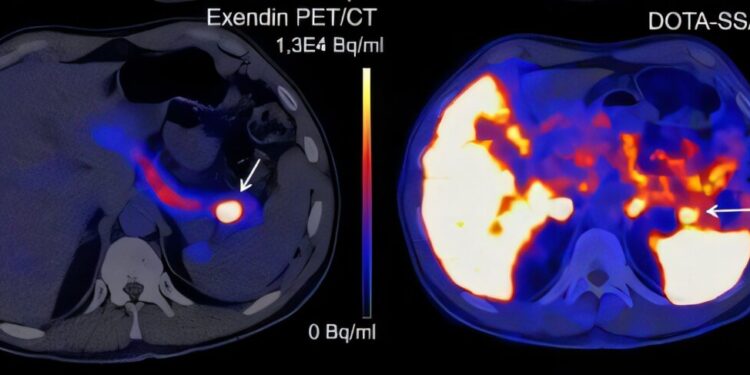This is a cutaway view of the torso. The gray areas show the CT-based anatomy, while the colored sections represent the radioactive signal measured by the PET scan. On the left, the new scanner using radioactive Exendin: the entire pancreas is visible, but the location of the benign tumor is very clear. On the right is the current analysis. Credit: Radboud University Medical Center
A new PET scan reliably detects benign pancreatic tumors, according to research led by Radboud University Medical Center. Current tests often fail to detect these insulinomas, even though they cause symptoms due to low blood sugar. Once the tumor is found, surgery is possible.
The pancreas contains cells that produce insulin, called beta cells. Insulin is a hormone that helps the body absorb sugar from the blood and store it in places like muscle cells. This regulates blood sugar levels. In rare cases, beta cells malfunction, leading to a benign tumor called an insulinoma. This tumor almost never spreads, but it still causes problems due to excess insulin production, leading to hypoglycemia.
Alternative to cutting pancreatic tissue
“People with this condition have little energy due to low blood sugar and often faint,” says Marti Boss, first author of the study. “It’s a very complex disease. It often takes a long time for patients to get a diagnosis. We can do blood tests, but they can’t confirm if a tumor is the cause or where it is. Various tests like CT scan, MRI and PET scans are available, but do not always show insulinomas.
Surgically removing the tumor solves the problem, but first you need to know the location of the tumor. Martin Gotthardt, professor of nuclear medicine at Radboudumc, explains: “In the past, surgeons would start cutting away parts of the pancreas until they found the tumor. If it was at the end, the entire pancreas would be gone. You can live without a pancreas, but you would struggle with severe diabetes and constantly have to manage your blood sugar levels. A better review was therefore urgently needed.
A new solution
Gotthardt and his team have developed a brand new scanner, called Exendin-PET scan, which allows the precise localization of insulinomas. They previously published the results of a study of children with congenital insulinoma. They now present the results of a study in adults, where insulinoma developed gradually.
The work is published in the Journal of Nuclear Medicine.
In the study, 69 adult patients suspected of insulinoma participated. The Exendin-PET scanner detected tumors in 95% of patients, compared to 65% with the current PET scan. When combined with CT and MRI, the current PET scan usually detects the tumor, but in 13% of cases the insulinoma is only visible on the new scanner.
Boss adds: “We believe the new scanner can replace all other scanners. All the insulinomas we found with the new scanner were removed and all of these patients were completely cured after surgery, even though some had been ill for decades.
Lizard-derived technology
The new analysis is based on a substance found in the saliva of the Gila monster, a type of lizard native to desert areas of the United States.
Gotthardt explains: “We knew that this substance bound specifically to a molecule present on these tumors, the GLP1 receptor. The substance from saliva was not very stable in the human body, so we created a more chemically stable version, called Exendin. attached a radioactive substance to it, so that it could be visible on a PET scan. Now this mildly radioactive Exendin appears to detect insulinomas perfectly.
The next step is to introduce the Exendin-PET scanner into clinics as a standard scanner for people suspected of having insulinoma. The researchers will now evaluate how the exam improves patients’ quality of life and how much money can be saved if other exams, such as CT scans and MRIs, are no longer necessary. Additionally, Gotthardt’s team is investigating the potential use of Exendin for the treatment of insulinomas in a new research project called LightCure.
More information:
Marti Boss et al, Improved localization of insulinomas using 68Ga-NODAGA-Exendin-4 PET/CT, Journal of Nuclear Medicine (2024). DOI: 10.2967/jnumed.124.268158
Provided by Radboud University
Quote: Scan based on lizard saliva detects rare tumor (October 21, 2024) retrieved October 21, 2024 from
This document is subject to copyright. Apart from fair use for private study or research purposes, no part may be reproduced without written permission. The content is provided for informational purposes only.



